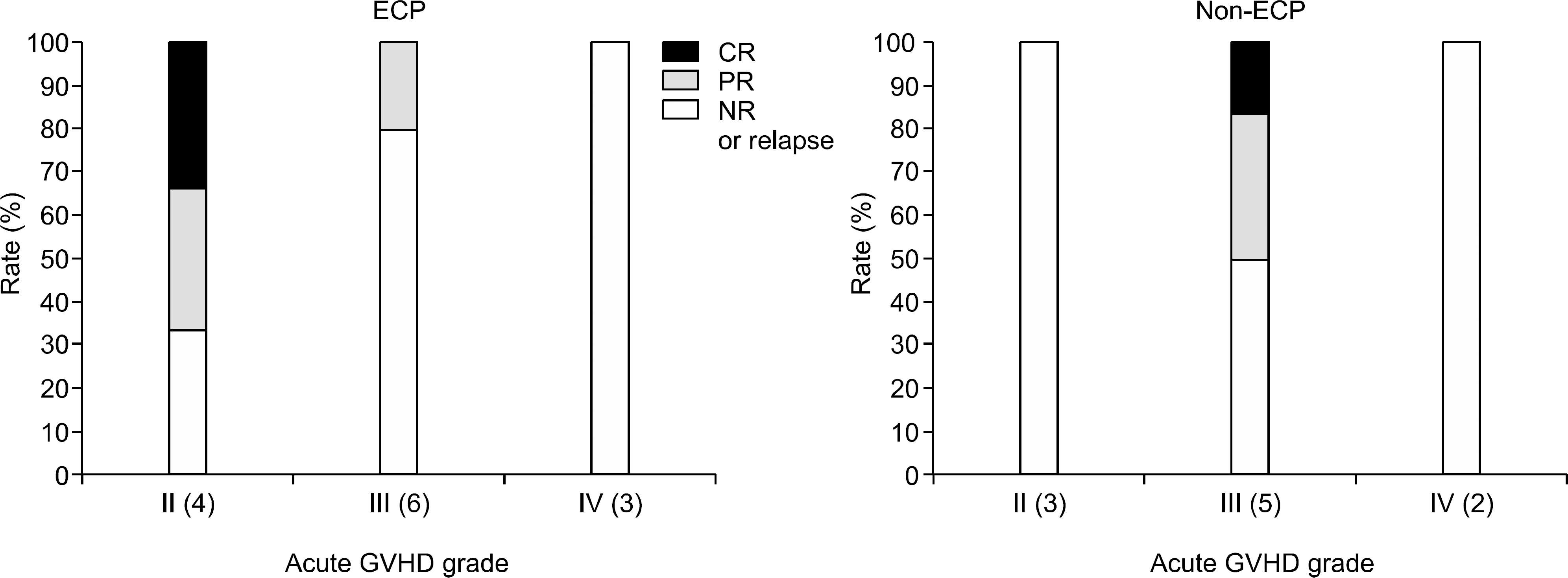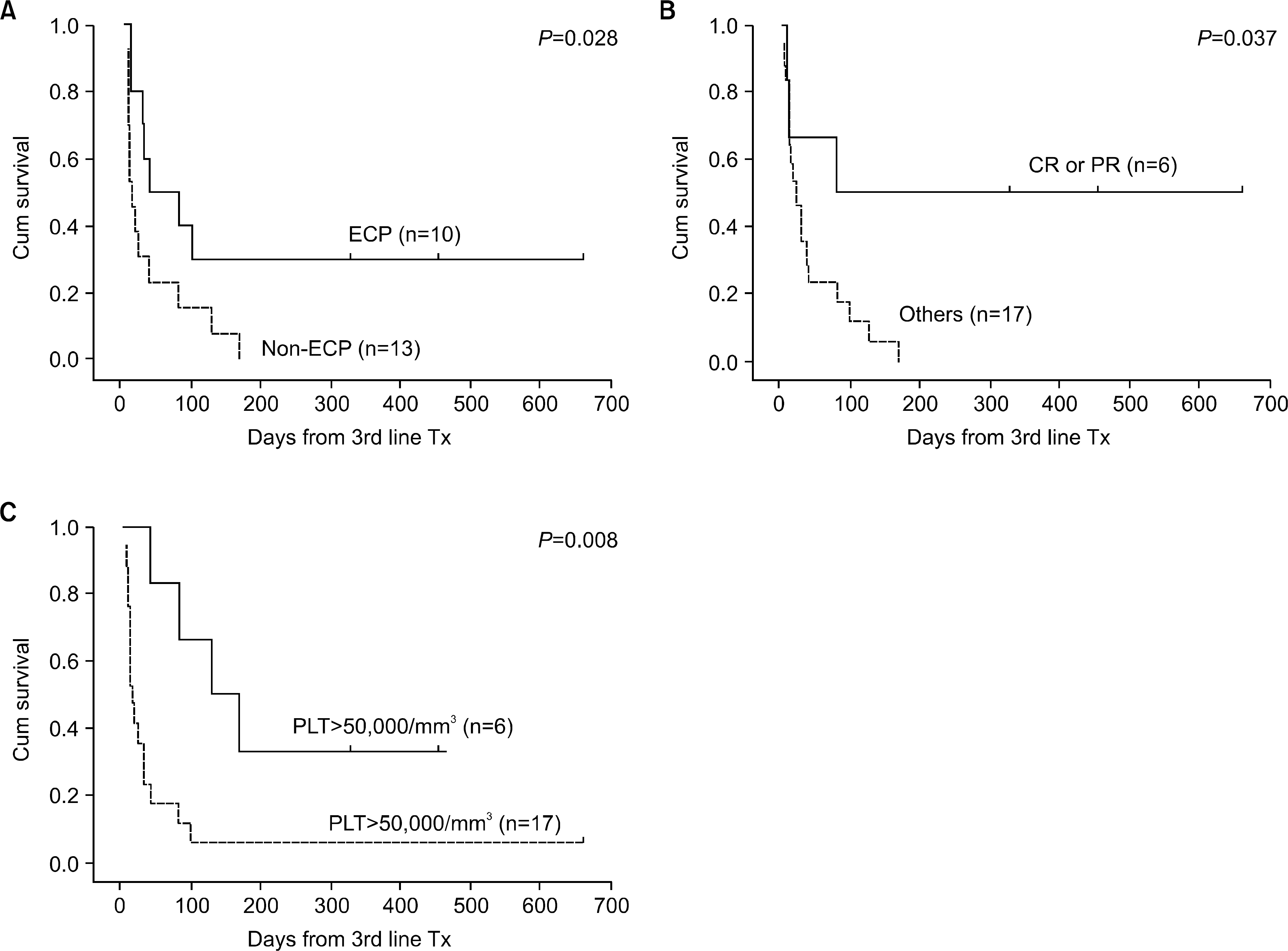Abstract
Background:
The mortality of patients with steroid resistant acute graft-versus-host disease (GVHD) after allogeneic hematopoietic stem cell transplantation (HSCT) is high due to multiple organ failure and infection. Recently, the use of extracorporeal photopheresis (ECP), which is believed to have a low risk of infection, has been applied for the treatment of GVHD.
Methods:
Of 23 patients who were steroid resistant acute GVHD that was resistant even to high dose steroid treatment as second-line treatment, 10 patients received ECP (ECP group) and 13 patients received a third-line treatment other than ECP (non-ECP group). The outcome including the response rate and survival for the ECP group and non-ECP group was analyzed.
Results:
The response rate of the ECP group including complete remission and partial remission, was 30%. The survival rate was 30% for the ECP group and 0% for the non-ECP group. The estimated mean survival time was 229.3±89.3 days for the ECP group and 41.8±14.6 days for the non-ECP group (P=0.028).
REFERENCES
1). Van Lint MT., Uderzo C., Locasciulli A, et al. Early treatment of acute graft-versus-host disease with high- or low-dose 6-methylprednisolone: a multicenter randomized trial from the Italian group for bone marrow transplantation. Blood. 1998. 92:2288–93.
3). Martin PJ., Schoch G., Fisher L, et al. A retrospective analysis of therapy for acute graft-versus-host disease: initial treatment. Blood. 1990. 76:1464–72.

4). Dall'Amico R., Rossetti F., Zulian F, et al. Photopheresis in paediatric patients with drug-resistant chronic graft-versus-host disease. Br J Haematol. 1997. 97:848–54.
5). Couriel D., Hosing C., Saliba R, et al. Extracorporeal photopheresis for acute and chronic graft-versus-host disease: does it work? Biol Blood Marrow Transplant. 2006. 12(1 Suppl 2):37–40.

6). Peritt D. Potential mechanisms of photopheresis in hematopoietic stem cell transplantation. Biol Blood Marrow Transplant. 2006. 12(1 Suppl 2):7–12.

7). Greinix HT., Volc-Platzer B., Kalhs P, et al. Extracorporeal photochemotherapy in the treatment of severe steroid-refractory acute graft-versus-host disease: a pilot study. Blood. 2000. 96:2426–31.

8). Greinix HT., Knobler RM., Worel N, et al. The effect of intensified extracorporeal photochemotherapy on long-term survival in patients with severe acute graft-versus-host disease. Haematologica. 2006. 91:405–8.
9). Przepiorka D., Weisdorf D., Martin P, et al. 1994 Consensus conference on acute GVHD grading. Bone Marrow Transplant. 1995. 15:825–8.
10). Urabe A. Clinical features of the neutropenic host: definitions and initial evaluation. Clin Infect Dis. 2004. 39(Suppl 1):S53–5.

11). Macmillan ML., Couriel D., Weisdorf DJ, et al. A phase 2/3 multicenter randomized clinical trial of ABX-CBL versus ATG as secondary therapy for steroid-resistant acute graft-versus-host disease. Blood. 2007. 109:2657–62.

12). Van Lint MT., Milone G., Leotta S, et al. Treatment of acute graft-versus-host disease with prednisolone: significant survival advantage for day +5 responders and no advantage for nonresponders receiving antithymocyte globulin. Blood. 2006. 107:4177–81.

13). First LR., Smith BR., Lipton J., Nathan DG., Parkman R., Rappeport JM. Isolated thrombocytopenia after allogeneic bone marrow transplantation: existence of transient and chronic thrombocytopenic syndromes. Blood. 1985. 65:368–74.

14). Akpek G., Lee SJ., Flowers ME, et al. Performance of a new clinical grading system for chronic graft-versus-host disease: a multicenter study. Blood. 2003. 102:802–9.

15). Pavletic SZ., Smith LM., Bishop MR, et al. Prognostic actors of chronic graft-versus-host disease after allogeneic blood stem-cell transplantation. Am J He-matol. 2005. 78:265–74.
16). Yamashita K., Horwitz ME., Kwatemaa A, et al. Unique abnormalities of CD4(+) and CD8(+) central memory cells associated with chronic graft-versus-host disease improve after extracorporeal photopheresis. Biol Blood Marrow Transplant. 2006. 12(1 Suppl 2):22–30.

17). Suchin KR., Cassin M., Washko R, et al. Extracorporeal photochemotherapy does not suppress T-or B-cell responses to novel or recall antigens. J Am Acad Dermatol. 1999. 41:980–6.
18). Lim HW., Edelson RL. Photopheresis for the treatment of cutaneous T-cell lymphoma. Hematol Oncol Clin North Am. 1995. 9:1117–26.

19). Couriel DR., Hosing C., Saliba R, et al. Extracorporeal photochemotherapy for the treatment of steroid-resistant chronic GVHD. Blood. 2006. 107:3074–80.

20). Foss FM., DiVenuti GM., Chin K, et al. Prospective study of extracorporeal photopheresis in steroid-refractory or steroid-resistant extensive chronic graft-versus-host disease: analysis of response and survival incorporating prognostic factors. Bone Marrow Transplant. 2005. 35:1187–93.

21). Salvaneschi L., Perotti C., Zecca M, et al. Extracorporeal photochemotherapy for treatment of acute and chronic GVHD in childhood. Transfusion. 2001. 41:1299–305.
Fig. 1
Response to third-line treatment according to the organ type. The numbers in the parentheses indicate the number of affected patients. Abbreviations: See Table 1.

Fig. 2
Response to third-line treatment according to the acute GVHD grade. The numbers in the parentheses indicate the number of affected patients. Abbreviations: See Table 1.

Fig. 3
Overall survival of patients with steroid resistant acute graft-versus-host disease as determined by the type of third-line treatment (A), the response to third-line treatment (B) and platelet count (C). P values were determined by the log-rank test.

Table 1.
Characteristics of 23 patients with steroid resistant acute GVHD who were treated with either extracorporeal photopheresis (ECP) or other treatment (non-ECP)
Abbreviations: ECP, extracorporeal photopheresis; non-ECP, third-line treatment other than extracorporeal photopheresis; SAA, severe aplastic anemia; AML, acute myeloid leukemia; ALL, acute lymphoblastic leukemia; MDS, myelodysplastic syndrome; CML, chronic myeloid leukemia; BM, bone marrow; PB, peripheral blood; DLI, donor lymphocyte infusion; GVHD, graft-versus-host disease; DI, documented infection; Tx, treatment; CMV, cytomegalovirus; LDH, lactate dehydrogenase.
Table 2.
Response to third-line treatment and survival of the patients with steroid resistant acute GVHD who were refractory to high dose steroid as an 2nd line treatment
Table 3.
Infection after third-line treatment in patients with steroid resistant acute GVHD
Table 4.
The indep survival of patients determined by mul pendent advers with steroid r tivariate analys se prognostic fa resistant acute sis actors for GVHD as
| Hazard ratio | 95 % C.I. | P value | |
|---|---|---|---|
| Platelet <50,000/mm3 | 14.342 | 1.313∼21.641 | 0.001 |
| Non-ECP | 5.343 | 1.670∼17.102 | 0.005 |
| Response <PR | 5.331 | 1.313∼21.641 | 0.019 |




 PDF
PDF ePub
ePub Citation
Citation Print
Print


 XML Download
XML Download